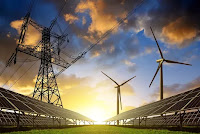It’s all about electrification.
These are gloomy times for electric utilities. After more than a century of fairly steady and predictable growth, they have entered stagnant waters. Demand for electricity is sluggish. Distributed energy resources (solar panels, batteries, etc.) are chipping away at their market share. Climate activists are always yelling at them for burning so many fossil fuels. It’s no fun.
Despite the industry’s much-hyped “death spiral” — in which customers abandon utilities for distributed energy, prices rise on remaining customers, more customers leave, etc. — these troubles are probably not fatal. Even under aggressive projections, most electricity will come from utility-scale power plants through the middle of the century. Utilities will still be needed. But they do seem to be heading inexorably toward a much-diminished role, with much-diminished profits.
Still, buck up, utility execs, all is not lost! There is a possible future in which utilities become bigger and more important than ever. What’s more, it is a future in which they take the lead in decarbonizing the country.
They could be heroes.
That is the good news in a recent paper from research consultancy The Brattle Group. It outlines a scenario in which utilities thrive, greenhouse gas emissions decline, and everyone joins hands in song.
The key to everything (coincidentally, my long-time obsession) is electrification.
Utilities are headed for stagnation
US utilities, as readers of my primer on utilities know, make money by spending money. Specifically, their profits come from return on capital investments made in new electricity infrastructure. (They don’t make money selling electricity itself; for that, they only recover costs.)
If they’re not investing in new electricity infrastructure, they’re not earning returns, and they’re not happy.
And it doesn’t look like much investment will be needed in coming years. It’s not just that distributed energy is chipping away at the need for those investments. It’s that demand for electricity is forecast to rise very slowly, if at all.
The US Energy Information Administration’s Annual Energy Outlook (AEO) for 2015 projects that between 2016 and 2040, US electricity demand will grow by an average annual rate of 0.6 percent — as compared with an average of 1.3 percent over the past 25 years.
...
Even if the US maxed out rooftop solar, it still wouldn’t get close to the long-term greenhouse gas targets it needs to hit to avoid dangerous climate change:
And that’s not all. Even if everything went right and the electricity sector completely decarbonized, the US still wouldn’t be close to the greenhouse gas targets it needs to hit:
That’s because electricity sector emissions are only about a third of the US total.
What to do, what to do?
Electrify everything
There is a clear and fairly well-understood path to zero carbon for electricity. The same cannot be said of energy services that run on liquid fuels — think gasoline for transportation and natural gas for heating. Efficiency can reduce those fossil fuel emissions, but it can’t eliminate them, and no economical zero-carbon liquid-based alternatives have emerged.
“An alternative path toward significant decarbonization of these sectors,” the Brattle authors write, “is to aggressively pursue electrification of transportation and heating.”
As I wrote in detail in a post last year, that’s a great idea!
To test what the shift could do for electricity sales, the researchers modeled “a steady conversion of transportation vehicles and residential and commercial heating devices away from burning fossil fuels and towards electric-powered alternatives, such that both sectors are fully electrified by 2050.”
Doing so, they conclude, “could lead to an increase of 3,560 TWh of new electricity demand by 2050 relative to the non-electrification [business as usual].”
Read more at How Electric Utilities Could Revive Their Sagging Fortunes and Decarbonize the Country

No comments:
Post a Comment